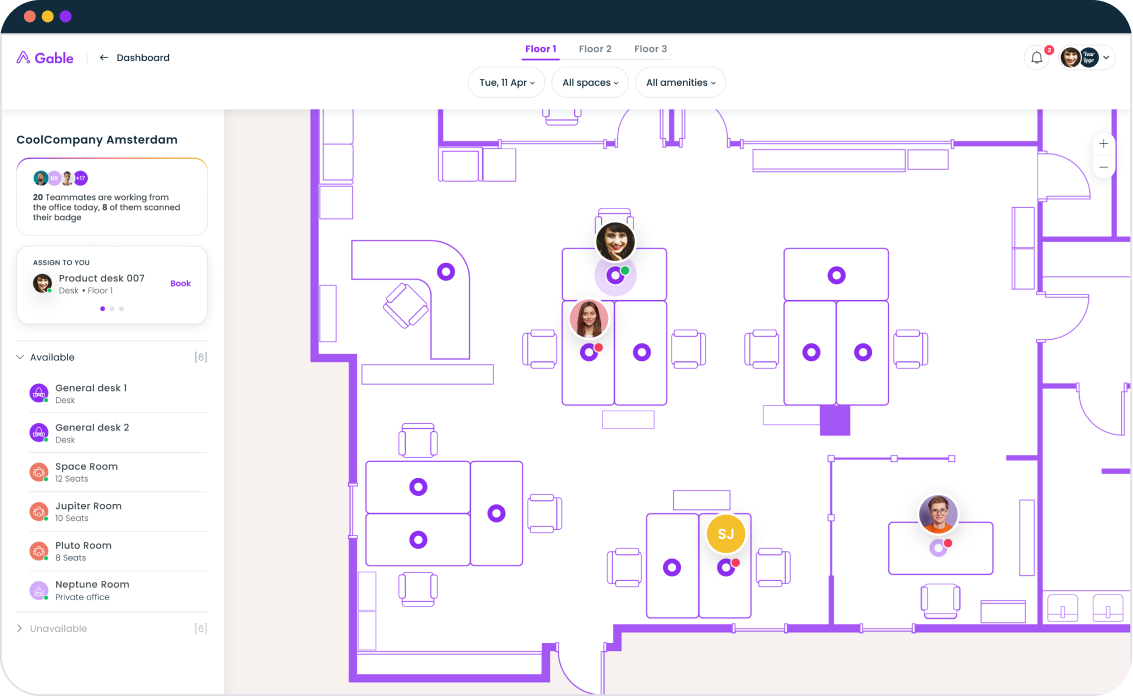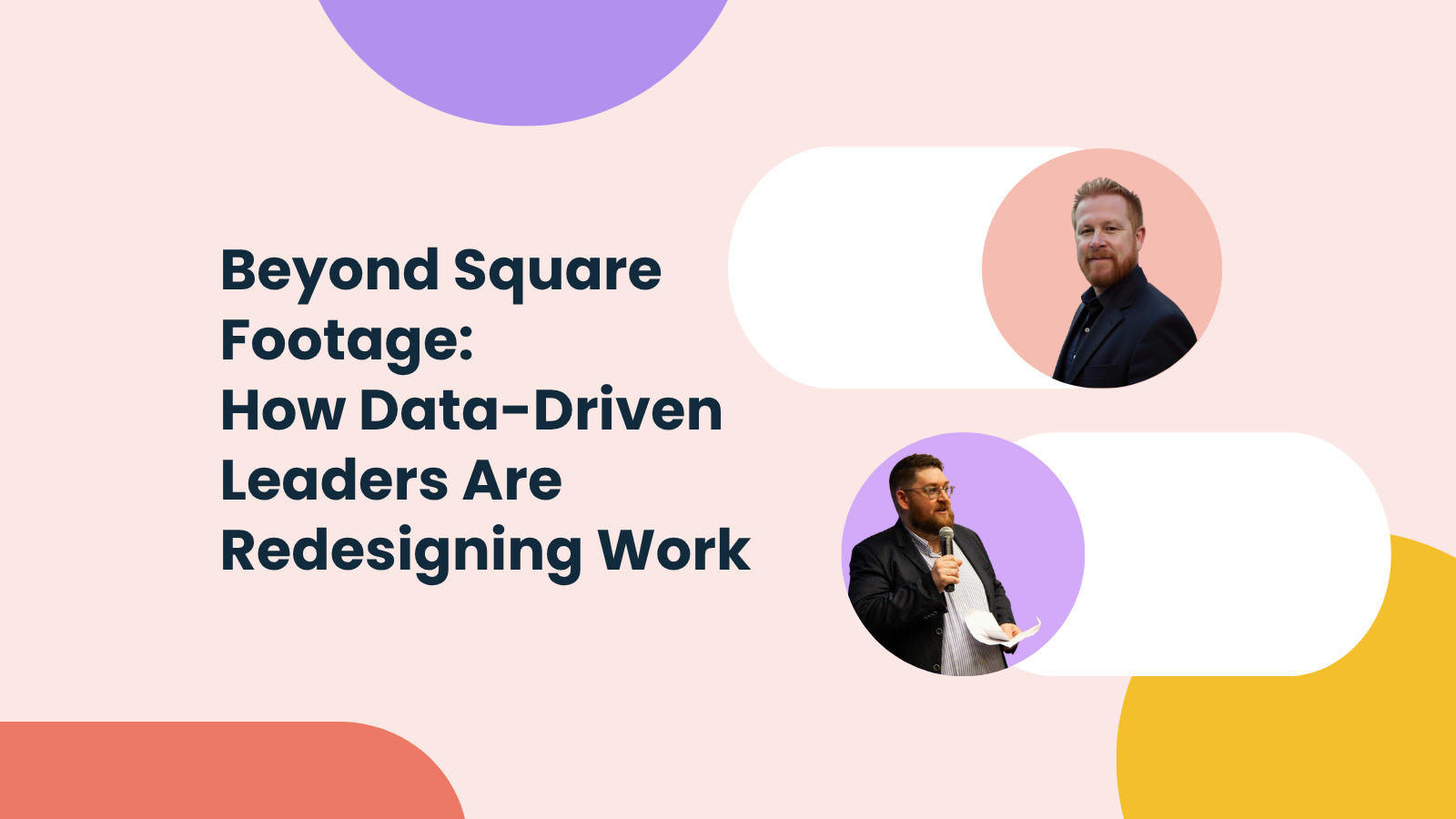This blog is a recap of a Gable webinar, Beyond Square Footage: How Data-Driven Leaders Are Redesigning Work. Watch the whole webinar here.
The old workplace planning formula is broken. For decades, it was simple: headcount + personas = square footage. Give us your team size and job types, and we'd spit out exactly how much office space you need.
But that cookie-cutter approach doesn't work when only 25-30% of workflows actually benefit from physical space.
Two workplace leaders who've navigated this transformation firsthand reveal how smart organizations are moving beyond traditional metrics to build strategies that actually work: Jeremy Salles, AVP Global Workplace Solutions at Marvell Technologies, and Ben Caunt, Global Head of Workplace Operations & Experience at Thoughtworks.
The Great Workplace Formula Breakdown: Jeremy's Journey
Jeremy's transformation began when he started managing Cisco's San Jose headquarters just three months before the pandemic hit. Like most workplace professionals, he expected the remote work experiment to last "maybe a few weeks."
"I was mostly a cookie-cutter workplace person," Jeremy explained. "You give me your headcount, you give me persona profiles, and I turn it into a big machine and spit out, okay, you need this much square footage, this many desks, this many offices."
But as weeks turned to months, Jeremy realized something fundamental had shifted. Employees weren't just surviving remote work; they were thriving. They managed work-life balance better, avoided wasteful commutes, and remained productive through virtual collaboration.
The key insight? Only 25-30% of most workflows actually require in-person interaction.
"If you're a group that's producing a product, and you've got 10 or so steps that you've got to do to get that product out the door, more often than not, two to three of those things require in-person, real interaction in real physical space," Jeremy shared. "And if you don't do them that way, your product quality suffers."
This realization shifted Jeremy's entire approach, from designing for all 10 steps to optimizing for the critical 2-3 that truly benefit from physical presence.

Get our free workplace utilization audit and identify optimization opportunities across your portfolio.
Get your copy
Building Global Strategy from Scratch: Ben's Framework Approach
Ben faced a different but equally complex challenge: building Thoughtworks' workplace function from zero across 20+ countries. The company had operated as "a company of companies" with hyper-localized real estate decisions, but global client demands required a more strategic approach.
"The thing that really stood out to me is that we can look at this at two levels," Ben explained. "There's the broad brush strokes around how we use an office. But then there's also the nuance underneath that of the cultural element."
He discovered dramatic differences in workplace preferences across cultures. Teams in Australia resist commuting and live closer to offices, while teams in India often commute 2+ hours daily but highly value in-person shared experiences and connection.
Ben's solution? A framework that balances global consistency with local flexibility, what he calls applying "evolutionary architecture" principles to real estate.
The Art and Science of Workplace Decisions
Both leaders emphasized that effective workplace strategy requires balancing data-driven decisions with human psychology, something Ben described as "if the data and the anecdote are telling you different stories, it's probably the data that's wrong."
When Thoughtworks' utilization data showed 5% office usage in 2022, the numbers seemed to suggest those spaces were failures. But digging deeper revealed the real story: those offices were heavily used for client visits and collaboration, but clients weren't counted in badge swipe data.
"We really kind of wanted to make sure we understood that local context after we'd done the spreadsheet activity," Ben said. "So that we were making good decisions that balance things and take into account that nuance."
The Future-Proofing Imperative
Perhaps the most striking insight from both leaders was their focus on future resilience rather than returning to 2019 norms.
Jeremy, now at Marvell where full-time office presence is currently mandated, acknowledges this approach works for their fast-paced semiconductor business today. But he's planning for tomorrow: "3-5 years from now, you're not going to be able to compete for talent. You're not going to be able to hire people. They're going to leave your company and go to your competitors."
His solution involves building workplace strategy from the ground up, starting with teams rather than individuals: "Each team should know what are those 2 or 3 things we absolutely have to do together in order to be successful. And they can start to build operating agreements around that."
Ben takes a similar evolutionary approach, designing workplace strategies that can adapt as business needs change: "We're protecting ourselves from change by embracing that change. You can either say, well, we're going to be fixed about that, or we go and say, yeah, it's gonna change, so how do we build that in?"
The Metrics That Actually Matter
When asked about the most valuable workplace metrics, both leaders immediately cited the same measurement: cost per visit.
"Just take your total cost of operating on the numerator, and take your total unique daily visits on the denominator," Jeremy explained. "It's a great metric to compare to co-working operations, right? So, is your real estate more expensive on a cost-per-visit basis than it would be to get a day pass at a really nice co-work?"
Ben added that this metric works because "you've got levers to pull there and to understand what is driving that cost per visit. Do people like coming to the space, and it's just expensive to operate? Or is it that you don't have very many visits, and it's a high cost?"
Jeremy's second-favorite metric is utilization (properly defined as the product of occupancy and attendance) because "people continue to be the most attractive part of our offices. The most engaging and most dynamic part of our offices."
The People-First Workplace
Both leaders emphasized that successful workplace strategies ultimately come down to understanding people, not just optimizing space.
"The number one amenity in our office, cited twice as often as any other amenity when people were polled about what they like about coming into the office, was other people," Jeremy shared.
Ben discovered that employees' emotional attachments to offices often weren't about the physical space itself: "When you dived into that, it wasn't actually about the space, it was about what the space represented. So for us, that was actually a really interesting challenge as a function to go, well, okay, we don't actually need that space, we need to do what that space represents for our people."
Beyond Square Footage
The conversation revealed that the future of workplace strategy isn't about perfecting utilization rates or optimizing cost per square foot. It's about understanding the fundamental question: which work actually benefits from physical presence, and how do we design intentionally for those moments?
As Jeremy put it: "It's more intention-based working. What is the intention of the moment that we're in? And how is the workplace environment enabling that intention to manifest?"
The leaders getting this right aren't panicking about 40% utilization rates or mandating arbitrary office days. They're asking deeper questions about how work actually gets done, building frameworks that can evolve with changing business needs, and designing workplace experiences that make in-person collaboration genuinely valuable.
Learn how data-driven strategies can transform your workplace effectiveness, reduce costs, and help provide top-notch employee experience across locations.
Get a demo





.svg)





.svg)


























